|
|
|
| |
|
The Autographed
Ball Company |
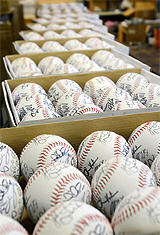 |
|
| All Welcomed ! |
 |
Baseball Memorabilia
& Collectibles |
|
1960s Hall Of Fame
Souvenir Baseball |
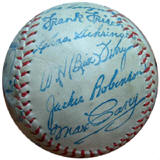 |
| with Stamped Signatures |
|
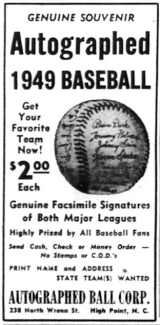 |
| Autographed Ball Co, Ad 1949
The Sporting News |
|
|
|
|
| KeyMan
Collectibles |
NEWSLETTER |
November 2010 |
|
|
FAKE SIMILAR AUTOGRAPHS - FACSIMILE |
 |
|
Steven KeyMan |
|
|
-
By Steven KeyMan |
|
Founder of
Keymancollectibles.com,
and a long time
collector, Steven
KeyMan has more than 30
years of experience in
researching, and
cataloging information
on Baseball
Memorabilia. First used
for his own personal
collection, and then by
helping others find
information on their
collectibles, the
website grew into the
largest online resource
for baseball
memorabilia |
|
|
|
|
|
| |
Ask
Steven: Direct your questions or feedback,
about Baseball Memorabilia to Steven KeyMan
Steve@keymancollectibles.com You can also Send
KeyMan pictures of your personal Memorabilia Display,
and get your own Free
Collectors Showcase Room featured on the website.. |
|
|
|
-Revised on 3/11/16 |
| |
"Ideal
gifts for baseball minded youngsters or
treasures for club rooms and dens"
Autographed Baseballs have been sold at
ballpark souvenir stands since 1948. These stamped
autograph baseballs were one of the
first souvenirs kids got when they went
to the ballpark with dad, and for
decades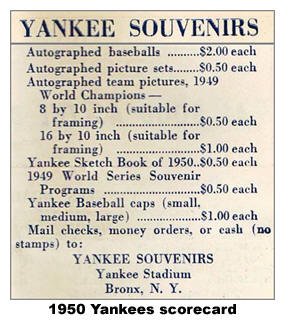 they were also beaten into
submission at the playground. they were also beaten into
submission at the playground.
Today many of these baseballs turn up
in estate sales, a box in the garage,
the closet, or found in the attic. They
are often mistaken for the real deal,
and land up on ebay. The
item description typically starts off
with something like "My Uncle recently
passed away, and was a big collector of
memorabilia....WOW! Look what I found
stashed in a box, I'm not an expert and
don't know for sure but it looks
real...."
These signatures are not fake, in the sense of being a forgery. They were
not made to fool anyone into thinking
they were real but they were advertised
as "autographs of your favorite
players" It was never mentioned that
the signature was preprinted on the
photo or stamped on the baseball. Back
in the day many people did buy them
thinking they were real and passed them
on to their kids as such. Thirty years
or so later the kids are heart broken,
only to find that the authentic hand
signed ball that was given to them by
dad, is a stamped autograph souvenir
baseball.
So, how can we tell the difference? Sometimes it's hard to tell
even by a seasoned hobbyist. These
autographs are pre-printed or
photocopied on photos, or made into
dyes from an actual signature of the
ballplayer. They are usually used on
Souvenir baseballs, promotional photos,
Postcards, Signature model Bats,
Gloves, advertising, etc.
A preprint or facsimile signature is simply a photographic
copy of an original signed photograph.
The
signature often appears to be below t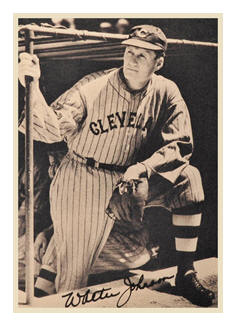 he
surface gloss of the photo, and the
signature is often very "flat." Hold
the photo up at an angle to a light
source. A real signature is written on
the surface of the photo, and should
have a different level of reflectivity
than the rest of the surface. A
preprint will blend right in because
it's underneath the surface gloss.
Obviously, preprint signatures will
match exactly, and the signature will
be in the same exact place on each
photo. With Balls, gloves or Bats, dyes
are created and stamped onto the
object. he
surface gloss of the photo, and the
signature is often very "flat." Hold
the photo up at an angle to a light
source. A real signature is written on
the surface of the photo, and should
have a different level of reflectivity
than the rest of the surface. A
preprint will blend right in because
it's underneath the surface gloss.
Obviously, preprint signatures will
match exactly, and the signature will
be in the same exact place on each
photo. With Balls, gloves or Bats, dyes
are created and stamped onto the
object.
With stamped autograph baseballs the ink is usually too consistent. When
you sign your name, you use different
angles, and pressure as you sign. This
is more evident when signing with a
sharpie. Some parts of the signature
will be darker, or lighter depending on
the pressure you put on the pen. A
signature created with a stamp or dye,
is usually all the same density, and
thickness. The ink pressure is consent
throughout the stamping of the
signature. When you cross a "T", or at
the end of your signature you might
tail off as you come off the page. A
stamped signature might start, and end
with no variation at all.
 The ink will
trend to be more uniform, or the same
density throughout. The ink will
trend to be more uniform, or the same
density throughout.
Other telltale signs that you might have a souvenir stamped autograph
baseball could be an interruption with
the flow of the signature caused by the
curvature of the ball. A part of the
signature might disappear, and
reappear, or skip. No disturbance with
the flow of the signature over the
seams. In some instances signatures
will have the given name of a noted
ballplayer, and not the name they are
known by or typically use when they
sign autographs. For example Henry
Aaron is used instead of Hank Aaron,
Larry Berra, instead of Yogi Berra, or
Ed Ford instead of Whitey Ford.
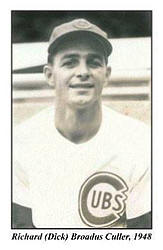 A brief history on the origins of these souvenir baseballs. The
Autographed Ball Company was founded in
1947 by Richard B. (Dick) Culler in
High Point, North Carolina. Culler
played baseball in the major leagues
from 1936 to 1949, for the Philadelphia
A's, Chicago White Sox, Boston Braves,
Chicago Cubs, and New York Giants. A brief history on the origins of these souvenir baseballs. The
Autographed Ball Company was founded in
1947 by Richard B. (Dick) Culler in
High Point, North Carolina. Culler
played baseball in the major leagues
from 1936 to 1949, for the Philadelphia
A's, Chicago White Sox, Boston Braves,
Chicago Cubs, and New York Giants.
Dick Culler had invented a technique to stamp facsimiles of players'
signatures on baseballs, so
team-autographed balls could be
mass-produced. A joint venture with ex
teammate Billy Jurges, the company
licensed the use of players' signatures
on the basis of one cent apiece for
each ball sold. The company sold balls
through concession stands in big-league
parks and also sold them through the
mail, as was the 1950 Dodgers team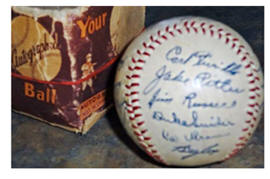 souviner stamped autograph baseball pictured.
souviner stamped autograph baseball pictured.
Producing replica team autographed baseballs for almost 70 years, the
Autographed Ball Company went out of
business in 2014. These baseballs
provided a history of the game
unequaled by any other product. The
balls were produced with current team
rosters and reflected midseason call
ups and trades. Team Balls made in
April, can be completely different by
October. The autograph dyes used for
the baseballs were created at the time
the order was placed. They did not keep
printed balls in stock from a previous
order.
A Note on the title of this newsletter: This
article "Fake Similar autographs -
Facsimile" has been revised and I
removed a paragraph about fake
signatures. I decided it was
irrelevant. The "Fake Similar" was a
play on words and now Fake is relevant
to Make. So I left the title alone.
The origins of the word facsimile: late
16th century (originally as fac simile,
denoting the making of an exact copy,
especially of writing): modern Latin,
from Latin fac! (imperative of facere
‘make’) and simile (neuter of similis
‘like’ -'similar')
|
|
| |
|
|
| |
KEYMAN COLLECTIBLES
RELATED RESOURSES |
|
| |
|
|
| |
 |
|
| |
|
|
| |
KeyMan
Collectibles Collectors Corner
- Keep up with the latest collecting news,
announcements, and articles of interest on the
webs best resource for baseball memorabilia. |
|
| |
Collectors Showcase - Half
the fun of collecting is showing it off to
others. Send KeyMan Collectibles pictures of
your Memorabilia Room or Display, and get your
own Free Collectors Showcase Room. |
|
| |
KeyMan Collectibles Baseball
Memorabilia Facebook Group -
Post Questions and comments relating to
Baseball Collectibles and Memorabilia. Interact
with other collectors or show off your
collection. |
|
| |
KeyMan Collectibles Network54 Forum
- A great option for those that "Don't do
facebook" Post Questions and
comments relating to Baseball Collectibles and
Memorabilia |
|
|
|
|
|


